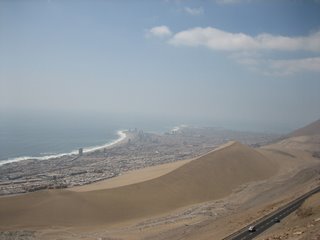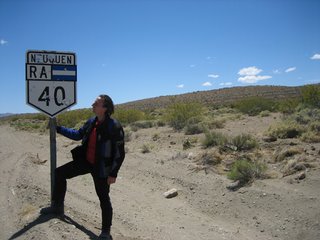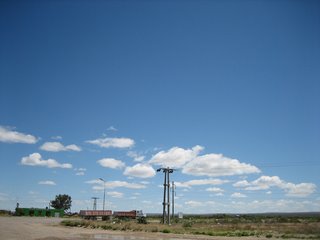Colombian peleton 30 January 2007
At the border between Ecuador and Colombian there’s a queue of around 100 people snaking out of the immigration office, along the shaded front windows of the administration buildings, out onto the pavement and into the sunshine. There are two immigration officers processing everyone, taking around five minutes for a standards stamp in or out and longer when oddities occur. The ice is soon broken as people debate the manpower situation and the first or final impression left with visitors. I’m amongst a lively crowed of Colombians, a grand old lady from Chile, a man from Peru and an American, who leaves in a rage after around thirty minutes. After an hour or two people begin to drift off for short periods, to get some lunch, find the Banos – toilets – or just stretch their legs. A procession of street traders bring by the contents of a small shopping centre, their captive audience willing to engage for a change. People gradually sit down and spread out, a potentially tedious time, becomes a relaxed afternoon in the sun. Everyone shares what they have with one another, the talk is fast and furious, with people kind enough to include me with the highlights in broken English. It almost seems a shame after five hours when I eventually reach the head of the queue. Everyone says goodbye, I get my check out stamps and head for Colombia to start the whole process again, where we all meet up again and pick up where we left off.
In the distance are the familiar orange cones running down the centre of the road, signalling a Colombian military check point. I spot a soldier holding up a red baton “Pare” – stop – written in white letter. There are around eight men visible, all dressed in army fatigues, Fidel Castro style caps. It’s hard to distinguish police from the army, as they all wear militaristic uniforms. They are young conscripts, probably about 18 years old, armed with SLR’s, overseen by a slightly older soldier, armed with a sub machine guns. I park up, open my visor and greet the young recruit with a smile, who taps on my panniers. I get off the bike and open them. On top of one is a paper back with Mark Thomas – Stand up comedian and activist, the book is about the arms trade and how companies like BAE bypass UN embargos – holding some kind of automatic riffle, which seems to have caught the soldiers attention enough for him to take across to the head honcho for further examination. The soldier in command spends a good few minutes thumbing through the book then motions to me as if patting a dog, it’s rude to call someone over using the European action of drawing a vertical hand towards the face as if fanning it. I’m a bit worried he might think the book’s some kind of revolutionary terrorist training manual. I walk over and he looks me in the eye for a moment, then in English with a thick Colombian accent he says “The arms trade, muy interesante”, as he hand back the book.
The cars you often see on the road in South America are like a trip back through yesteryear. People often know the story of the VW Beetle, still produced in Brazil and Mexico until a few years ago, well the same is true of plenty of other 70´s classics. My favourite has to be the box like Renault 4, with its dashboard shift, but it doesn’t stop there, Renault seemed to have shipped there entire plant from that period, making up until very recently, the entire range from that era. I know it’s not most people idea of a classic, but I’d be quiet happy to drive around in a brand new Renault 4 back home.
After a night in Popayan, I head out of town heading north. It’s early Sunday morning, a light mist hanging over the Colonial Spanish buildings. I reach the main road as peleton of around 50 cyclists, rushes past, everyone on a racing bike, fully kitted out with Tour de France style shirts and shorts. In Colombia, cycling is a huge sport and as I continue to ride up into the mountains I continue to pass groups of racers small and large, often lead or tailed by a car with bikes secured to a roof rack. The terrain is undulating hills with a mass of thick green foliage, waterfalls and rock slides forcing their way through on occasions. Climbing one particularly steep and windy piece of road four or five teenagers belt past in the opposite direction, riding BMX´s, their chins resting on the handle bars. I can help thinking the down side has to be the back breaking peddle back up with no gears, but they’ve got this covered. A few miles on an articulated lorry crawl past me, its trailer towing a couple of lads on their BMX´s.
There are regular toll booths, preceded by ramps to slow the traffic, an impromptu food and drink stop for many. As the traffic slows to queue to go through the booths, hoards of street traders appear at the driver and passenger windows, offer light snacks, ice creams, fruit, juices, maps, monkeys, exotics birds and more. You can even make phone calls as the now familiar cry of “Llamadas, llamadas” – “Calls, calls” – rings out. Throughout Colombia, people with mobiles attached to chains, signs around there necks saying “$300 minuto”, - The $ sign is used to represent passos - selling minutes on there monthly contact, hoping to make a small profit. There are numerous micro businesses in Colombia. Outside the post offices, people sit at tables with type writers on them, dictate a letter or have then craft your CV. The coffee men and women patrol their patch, homemade trolleys holding around 20 thermos flaks, they spend the day keeping everyone topped up with caffeine. Shoe shine boys and men are everywhere, providing shade and the morning paper for their customers, who are plentiful. At a quiet village I pulled into a small petrol station with a restaurant, the roof is thatched with palms, so dried they’re almost silver. After eating I return to my bike, noticing cardboard on the windscreens of each vehicle to keep out the heat and on my saddle, another sheet of cardboard. I hand a young lad a few coins, you have to take reward initiative.
If you’re not at the top of the pile, life is tough for people in Colombia and there is a huge golf between rich and poor, which is acutely visible in cities such as Medellin. Driving past the vast favelas, families often live in one room buildings they have built themselves, while a few miles down the road, vast tracts of land are home to modern, gated, high rises. The grounds are landscaped, often with pools, heavily armed guards with dogs manning the gates and patrolling the perimeters. The same heavy security is present at the many up market restaurants, bars and boutiques. The poverty on the other side of the divide is what helped Pablo Escobar establish and maintain what was the Worlds most successful drug cartel for so many years. At it’s height, the Medellin cartel was turning over 18 billion dollars a year, some of which was used to help the poorest, giving rise to an engineered Robin Hood type reputation. In the later years this enabled Pablo to elude capture as he found sanctuary and protection in the favelors. The down side was the violence, at the cartels height, the murder rate in Medellin stood at over 30,000 deaths a year, not to mention the beatings and bullying. Pablo Escobar was eventually in 1993, in a joint offensive against him and his cartel mounted by both the Colombian and US government.
The second front of violence for many years came from the FARC & ELN, whose support has been eroded by the fall of communism, along with the present administration policy of confrontation and dialog with both organisations, along with dramatically increasing the size of the army and police forces. Security has been bolstered around main roads and cities, pushing the FARC & ELN into the hills and countryside.
Today Colombia is relatively safe, although you do still hear stories. I met two guys from Manchester who were particularly unlikely, being held up at gun point twice, once in a park – it was three in the morning and they’d has quiet a few beers - and on anther occasion when they walked into an internet cafe that was being held up. The FARC still set up road blocks and people warn you to keep an eye on oncoming traffic, if there is none for more than around 10 minutes pull over and wait. Also, motorcyclists in Colombia wear bibs displaying their number plates, front and back in large reflective letters. I didn’t find out about the law until a day or so ago, which was introduced to stem the rise in drive by motorcycle shooting. The irony is, all the stories of violence don’t tell the true story of Colombia. I have almost always been welcomed with warm smiles and friendship, the people have continually gone out of their way to help me. Add to that the climate, the eternal spring, never too hot, never too cold and surly it’s the perfect combination.
Driving through a deserted industrial area, the taxi pulls up outside a poorly lit entrance. There are two police on a motorcycle, the pillion has a pump action shot gun pointing into the air, the butt resting on his hip, the rider a sub machine gun around his chest. The door men are searching people carefully before allowing them through a second line. Inside, the club is long and thin. There is a furnished mezzanine floor, with a DJ booth, the rest of the club is unfurnished. The ground floor has a bar at the far end, there are black drapes covering the walls of what was once a warehouse. Large speakers hanging down on thick chains, an array of strobes and prism lights catching the rising smoke which seems to be more than just Marlborough lights. Compared to the bars, restaurants and clubs I’ve been to previously Medellin’s middle classed district of “El poblado”, this place is a lot more earthy, with heavy hip-hop, reggaetón – Jamaican dance hall and reggae, blended with Latin American styles - and dub. It’s getting on for 3am and the club is packed with everyone swaying in unison. I’m out with a couple of people from the hostel, Julian and a Poland – he won’t tell anyone his real name. The drink of choice is quarter bottles of rum, which line the hip height shelves running the length of the club, away from the bar. We buy a bottle and some coke and are passed three glasses full of ice. Poland disappears into the thick of it and we watch as he chats and joking with the locals, filling their faces with a mix of smiles and bemusement. An hour or so later I’m suddenly tapped on the shoulder, its Poland. The music loud and I’m not sure what he’s saying, but he seems to want us to follow him. He’s with a Colombian in a smart white shirt and Kengol flat cap on backward. We follow in procession weaving our way through the crowded dance floor up to the mezzanine floor. It’s suddenly becomes like something out of a film, as towards the back of the room is a shady figure surrounded by an entourage, which seems to be mainly private security, dressed normally, but scanning the room. People seem to know who this group and are keeping either a respectful or cautious distance. I decide to hang back, as Poland strides forward to be introduced and with his usual out going, tactile approach, slaps the central figure on the back as he shakes his hand, shouting something in his ear. Then there is “A moment”. Perhaps it’s a piece of intentional drama, intimidation or he could feel insulted. It’s seen as very rude in Colombia and most of South America not to look people directly in the eye when shaking hands or making a toast. “The moment” hangs there for what seems like an age, there is an obvious tension in the room, his henchmen and the rest of the room seem to be waiting for a reaction. Poland then burst out laughing, holding out his hand and perhaps inadvertently stares him straight in the eye. He’s met with a motionless, deadpan, icy stare. It doesn’t look good, then very slowly his face melts into a smile, then a head nodding laugh, as he grabs Poland’s hand and shakes it. You can feel whole mezzanine area relax again as the music fills the void, my queue to go back down to the bar for to get for some more rum and coke.
There are no roads connecting Colombia with Panama, the two countries are divided by swamp land and forest known as the Darien Gap. To get to Panama I need to find a boat in Cartagena or fly from Bogotá. The boat trip includes a couple of days on the San Blas islands, you classic desert islands, with just a handful of inhabitants, so there’s no contest, the boat it has to be. In Cartagena I head to “Club Nortico”, where I’ve been told I’ll be able to find a private yacht big enough to take me and the bike across this notorious piece of water to Panama. On arrival at the marina I soon get talking to a German call Andreas, it seems there are no boats sailing at the moment, as it’s “The windy season”. I get a few more contact in town and on the internet. In total I speak either verbally or via email, around half a dozen people, all telling the same story. It seems everyone’s moored up until the middle of February. There is lucrative trade in taking people around the Darien Gap, so for all the main players to be anchored, it seems pretty conclusive. Back at Club Nortico I give it one more try, it seems most people here are sailing around the world. It’s the hurricane season in the pacific, so everyone is waiting in the Caribbean waters until late March, before going through the Panama Canal, to continue south. It looks like I’ll be back on my bike heading towards Bogotá to air freight, what a crying shame.













